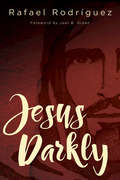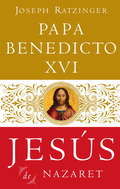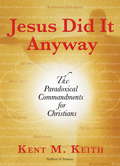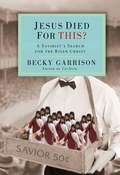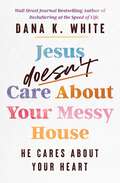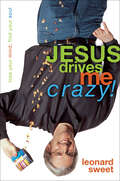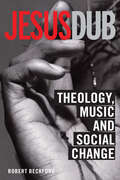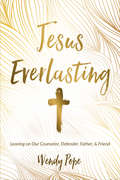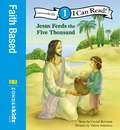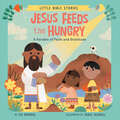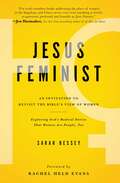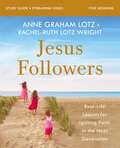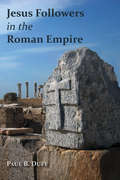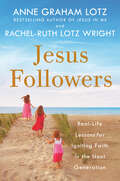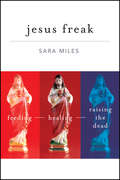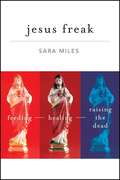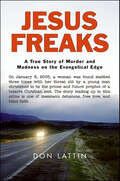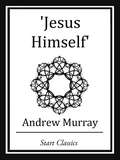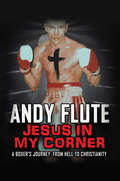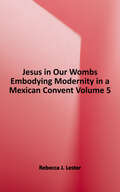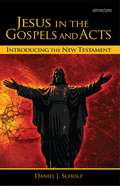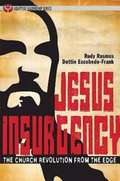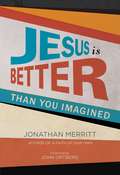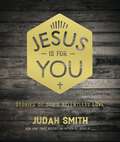- Table View
- List View
Jesus Darkly: Remembering Jesus with the New Testament
by Joel B. Green Rafael RodriguezNew Testament students have not always been well served by study of the historical Jesus, which tends to segregate Jesus from his significance vis-à-vis Israel’s scriptures and God’s agenda as this is developed among the New Testament writers in the living context of a faith community’s memory. The witness of scripture does in fact help us remember Jesus well. The Bible is one story, from beginning to end – a story of God putting God’s family back together. Its plot develops in multiple, sometimes competing, ways. It exhibits the full range of human emotions and, perhaps surprisingly, it claims that these are also God’s emotions. But on every page, we hear the call of a God whose family has chosen an early inheritance instead of an intimate relationship. That God – pictured as a parent, often a father – beckons God’s children, inviting them to return and to sit at the table, clothed by mercy and affirmed as God’s very family.
Jesus De Nazaret
by Joseph Ratzinger Papa Benedicto XviEn este original y oportuno libro --el primero que escribe desde su elección como papa--, Benedicto XVI rescata la figura de Jesús de recientes descripciones «populares» y restaura la verdadera identidad de Jesús que nos presentan los Evangelios. El papa, con su excepcional lucidez como teólogo y su convicción personal como creyente, nos presenta un retrato de Jesús impactante y veraz, y nos invita a encontrarnos cara a cara con la figura principal de la fe cristiana.De Jesús de Nazaret: «La gran pregunta que nos acompañará a lo largo de todo este libro: ¿qué ha traído Jesús realmente, si no ha traído la paz al mundo, el bienestar para todos, un mundo mejor? ¿Qué ha traído?La respuesta es muy sencilla: a Dios. Ha traído a Dios. Aquel Dios cuyo rostro se había ido revelando primero poco a poco, desde Abraham hasta la literatura sapiencial, pasando por Moisés y los Profetas; el Dios que sólo había mostrado su rostro en Israel y que, si bien entre muchas sombras, había sido honrado en el mundo de los pueblos; ese Dios, el Dios de Abraham, Isaac y Jacob, el Dios verdadero, Él lo ha traído a los pueblos de la tierra.Ha traído a Dios: ahora conocemos su rostro, ahora podemos invocarlo. Ahora conocemos el camino que debemos seguir como hombres en este mundo. Jesús ha traído a Dios y, con Él, la verdad sobre nuestro origen y nuestro destino; la fe, la esperanza y el amor».From the Trade Paperback edition.
Jesus Did It Anyway: The Paradoxical Commandments for Christians
by Kent M. KeithThe author of Anyway delivers an inspirational new volume. Kent M. Keith first articulated the ten timeless principles as a college student in the 1960s, and put them in the classic book Anyway. His modern credo for finding personal meaning in the face of adversity became a sensation and has been quoted for decades. Now, the author presents an important and inspiring new book illustrating the paradoxical commandments through Bible stories and verses. In Jesus Did It Anyway, Keith draws from the Old and New Testaments to demonstrate how the paradoxical commandments are grounded in Scripture and the Christian faith. Inspiring stories illuminate the paradoxical commandments by examining how Jesus and other biblical figures lived their faith against tremendous adversity-but always knew they were divinely blessed. In this enlightening book, Keith reveals how answering Jesus's call to live a paradoxical life can lead to the deepest personal meaning and spiritual fulfillment.
Jesus Died for This?: A Religious Satirist's Search for the Risen Christ
by Becky GarrisonFrom the author: When I arrived at Yale Divinity School back in 1988, I expected to engage in an intense period of discussion and self-reflection around issues like eschatology, evangelism, and ecclesiology with fellow Protestants of all stripes (with a few Catholics thrown in as sort of a guilty pleasure). After all, despite our theological differences, surely we all at least bought into this Nicene Creed biz where it clearly states that Jesus was born, died, and then rose again from the dead? Silly me. Instead way, way, way too much time was spent navel gazing over trivial topics like Why can’t priests be promiscuous? What priestly perks come with this parish? Is YDS a Christian’ divinity school? (This Q comes courtesy of the fundy faithful) and my favorite Why don’t you use ^%$#@ inclusive language in worship? (Uh, Jesus was a “dude.” Hello.) I just don’t see why the creator of all, who loves all of her creation unconditionally, would bring his son into the world to suffer, die, and then rise from the dead unless he knew such an act was needed to transform the world. There’s no way God would have given us the gift of eternal life just so we could stage Christian catfights that make us all look like biblical buffoons. Yes, we can point the finger at silver tongued televangelists and politicians behaving unbiblically. But the more I cover Christian carnage, I realize that this foolish quest to conform Christ’s teachings to the whims of one’s own socio-political agenda has started to stink up the local churches big time. I know Jesus was born in a barn but do churches have to smell like one as well? In I Died for This? I will pick up my pitchfork and muck out the spiritual stables for signs of the living Christ hidden under the mounds of Jesus junk and faith fertilizer. My search will start when I first set foot in the Promised Land in January 2007 and conclude with the 2008 election a.k.a. the Presidential Promised Land. Along the way I will expose emergent excesses, debunk democratic dogma and other biblical bunk that separates us from the radical rule breaking, love making rabble rouser who came to save us all.
Jesus Doesn't Care About Your Messy House: He Cares About Your Heart
by Dana K. WhiteThe phrase &“cleanliness is next to godliness&” isn&’t found in the Bible. Your house can never be good enough to please God—not because you can&’t scrub it or declutter hard enough, but because that is never what He was looking for in the first place. Join Dana K. White, author of Decluttering at the Speed of Life, as she works through removing the shame associated with having a messy home and reveling in the grace and love of our Savior.This book is for you, if no matter how competent you feel in other parts of your life, you still feel overwhelmed and defeated by your messy home. While it&’s true that keeping a clean and organized living space can contribute to a sense of peace and well-being, it should never be equated with your worth, moral standing, or what Jesus thinks about you. Dana K. White, trusted by millions for her no-holds-barred cleaning confessions and practical decluttering method wants to:remove any shame or identity crisis associated with disorganizationhelp you understand God's love and purposeful design for you that is much bigger than any mess in your house. Sharing relatable stories, biblical teaching, and practical life application, Dana will help you find a sense of freedom, acceptance, and a deeper understanding of God's love and purpose for you and your house.
Jesus Drives Me Crazy!: Lose Your Mind, Find Your Soul
by Dr. Leonard SweetThe gospel presents a life-changing NUTS wisdom that conflicts with normal ways of making sense of the world. There is the World According to Normal. There is the World According to NUTS . . . where NUTS is an acronym for Never Underestimate the Spirit. The wisdom of Jesus is a NUTS wisdom.—From the book All people are different, but some are more different than others. Christians are meant to be the most different of all. Yet we often “normalize” God. We judge what is a successful Christian and a successful church by the world according to Normal, not the world according to NUTS, the wisdom of Jesus.In Jesus Drives Me Crazy!, Leonard Sweet reminds us of the “crazy wisdom” of Christ and how our lives and our churches can and should be different from the way “normal” people live. He says, “Jesus wants to drive you crazy . . . crazy in love with God, with life.” Jesus Drives Me Crazy! challenges you to make the upside-down wisdom of God your own, inspiring you to live an extraordinary Christian life that does not conform to the world, but transforms the world.When you truly grasp the freeing truth that we do not have to conform to this world, then you can become the crazy, zany, unpredictable, but powerful force for Jesus you were intended to be. Jesus Drives Me Crazy! shows how, by losing your mind, you can find your soul.
Jesus Dub: Theology, Music and Social Change
by Robert BeckfordRobert Beckford explores the dialogue between two central institutions in African Caribbean life: the church and the dancehall. He highlights how Dub – one of the central features of dancehall culture – can be mobilized as a framework for re-evaluating theology, taking apart doctrine and reconstructing it under the influence of a guiding theme. Engaging with the social and cultural heritage that informs Christian African Caribbean culture, including the influence of slavery, Revival Christianity and working class Jamaican life, Black theology and music ranging from post-war Sound System to American Hip Hop, Jesus Dub is a detailed exploration of how throughout history, music and faith have been transformed in response to racialised oppression. Finally, Beckford demonstrates that dub style appears in the teachings of Jesus, and that Dub is a tool which can provide new ways of envisaging and practising spiritual gifts and financial giving, proposing a more inclusive theology for everyone.
Jesus Everlasting: Leaning on Our Counselor, Defender, Father, and Friend
by Wendy PopeWhen daily stresses and fears feel overwhelming, women want to know above all that Jesus is with them. With her approachable style and passion for digging into God&’s Word, Wendy Pope invites women to put themselves in the scenes of Jesus&’s encounters with five women. Readers will discover that they too can get to know Jesus as a: Friend who will never leave themFather who brings healing and hopeDefender who protects themCounselor who truly knows themJesus Everlasting includes thought-provoking questions, journaling space, and unique explorations of six hymns to draw readers closer to their Savior. This is a timely invitation for women to understand more of who Jesus is, was, and will be for every tomorrow.
Jesus Feeds the Five Thousand: Level 1 (I Can Read! #Level 1)
by Crystal BowmanChristian parents especially appreciate books for their young readers that help them understand more about God. Reading the Bible can be a very overwhelming challenge for young readers. Therefore, Bible stories written in a learn-to-read format are a welcomed product. This is the idea behind the proposal Bible Stories for I Can Read! Level1. When interesting stories from the Bible are written with on-level vocabulary, the child gains knowledge of Scripture and biblical truths while developing his or her reading skills. The result is a meaningful and positive reading experience for the child. Possible titles include: Old Testament: Twelve Special Stones, The Life of Samuel, Elijah and Ahab at Mt. Carmel (1 Kings 18), The Healing of Naaman (2 Kings 5), New Testament: The Two Sons, Jesus Feeds 5000 (Matthew 14, Mark 6, John 6), Lazarus Rises from the Dead (John 11), Jesus Walks on Water (Matthew 14), Saul’s Conversion (Acts 9)
Jesus Feeds the Hungry: A Parable of Faith and Gratitude (Little Bible Stories)
by Pia ImperialShare the Biblical tale of Jesus feeding the five thousand with your little one and celebrate the power of prayer and faith together!Simple and biblically accurate text introduces readers to the most beloved stories of the Bible. Jesus Feeds the Hungry is the perfect gift for parents and other caretakers who are looking to share their love of Christ with their young ones and highlight the values of sharing what you have, not being wasteful, and showing gratitude for food.
Jesus Feminist: An Invitation to Revisit the Bible's View of Women
by Sarah BesseyWritten with poetic rhythm, a prophetic voice, and a deeply biblical foundation, this loving yet fearless book urges today&’s church to move beyond man-made restrictions and fully welcome women&’s diverse voices and experiences.A freedom song for the church. Sarah Bessey didn&’t ask for Jesus to come in and mess up all her ideas about a woman&’s place in the world and in the church. But patriarchy, she came to learn, was not God&’s dream for humanity. Bessey engages critically with Scripture in this gentle and provocative love letter to the Church. Written with poetic rhythm, a prophetic voice, and a deeply biblical foundation, this loving yet fearless book urges today&’s church to move beyond man-made restrictions and fully welcome women&’s diverse voices and experiences. It&’s at once a call to find freedom in the fullness, hope, glory, and work of Christ, and a very personal and moving story of how Jesus made a feminist out of her.
Jesus Followers Bible Study Guide plus Streaming Video: Real-Life Lessons for Igniting Faith in the Next Generation
by Anne Graham Lotz Rachel-Ruth Lotz WrightHow can we ignite faith in the next generation?We are all in a relay race called life. The Baton is Truth that leads to faith in Jesus Christ. Each generation receives the Baton from the previous generation, who runs the race to the best of their ability and is then responsible for passing it smoothly and securely to the next generation. As parents, grandparents, and mentors, we must be intentional as we seek to ignite faith in the next generation by receiving, running with, and relaying the Truth that leads to personal faith in Jesus Christ.Join Anne Graham Lotz and Rachel-Ruth Lotz Wright for this five-session study as they demonstrate a family Bible study discussion, plus four ways to ignite faith in the next generation, centered around your Witness, Worship, Walk, and Work. Intentionally following Jesus in these aspects of your daily life will make you more effective as you seek to ignite faith in the next generation.This study guide includes:Individual access to five streaming video talks from Anne and Rachel-RuthWeekly individual Bible studiesGroup discussion questionsA Facilitator&’s GuideAnswers to frequently-asked questionsSessions and video run times:Bible Study Workshop (46:00)Our Witness (25:00)Our Worship (24:00)Our Walk (30:00)Our Work (29:00)This study guide has everything you need for a full Bible study experience, including:The study guide itself—with discussion and reflection questions, video notes, and a leader's guide.An individual access code to stream all video sessions online. (You don&’t need to buy a DVD!)Streaming video access code included. Access code subject to expiration after 12/31/2027. Code may be redeemed only by the recipient of this package. Code may not be transferred or sold separately from this package. Internet connection required. Void where prohibited, taxed, or restricted by law. Additional offer details inside.
Jesus Followers in the Roman Empire
by Paul B. DuffWhen Jesus of Nazareth began proclaiming the kingdom of God early in the first century, he likely had no intention of starting a new religion, especially one that included former pagans. Yet a new religion did eventually develop—one that not only included non-Jews but was soon dominated by them. How did this happen?Jesus Followers in the Roman Empire by Paul Duff offers an accessible and informed account of Christian origins, beginning with the teaching of Jesus and moving to the end of the first century. Duff's narrative shows how the rural Jewish movement led by Jesus developed into a largely non-Jewish phenomenon permeating urban centers of the Roman Empire. Paying special attention to social, cultural, and religious contexts—as well as to early Christian ideas about idolatry, marriage, family, slavery, and ethnicity—Jesus Followers in the Roman Empire will help readers cultivate a deeper understanding of the identity, beliefs, and practices of early Christ-believers.
Jesus Followers in the Roman Empire
by Paul B. DuffWhen Jesus of Nazareth began proclaiming the kingdom of God early in the first century, he likely had no intention of starting a new religion, especially one that included former pagans. Yet a new religion did eventually develop—one that not only included non-Jews but was soon dominated by them. How did this happen?Jesus Followers in the Roman Empire by Paul Duff offers an accessible and informed account of Christian origins, beginning with the teaching of Jesus and moving to the end of the first century. Duff's narrative shows how the rural Jewish movement led by Jesus developed into a largely non-Jewish phenomenon permeating urban centers of the Roman Empire. Paying special attention to social, cultural, and religious contexts—as well as to early Christian ideas about idolatry, marriage, family, slavery, and ethnicity—Jesus Followers in the Roman Empire will help readers cultivate a deeper understanding of the identity, beliefs, and practices of early Christ-believers.
Jesus Followers: Real-Life Lessons for Igniting Faith in the Next Generation
by Anne Graham Lotz Rachel-Ruth Lotz WrightThe daughter and granddaughter of Billy Graham share inspiring stories from their family life that offer compelling insights for leaving a legacy of faith.Passing on our faith does not happen passively—it&’s something we intentionally pursue with prayer and joy. Yet many of us struggle to know what it looks like to live out a contagious faith in today&’s world. We long for spiritual wisdom on how to ignite faith in our children, grandchildren, and others we encounter. Jesus Followers offers practical ideas, biblical teaching, and inspiring true stories from Anne Graham Lotz and her daughter Rachel-Ruth Lotz Wright for effectively running the race of faith and passing the Baton of Truth to the next generation. Drawing on the fascinating genealogy of Genesis 5, Anne explores the unique impact of our witness, worship, work, and walk. Rachel-Ruth illustrates each of these critical elements with stories from the Graham and Lotz families, offering vivid descriptions of how God&’s truth was passed on by word and example. Jesus Followers not only offers a glimpse into the living rooms and prayer closets of a faith-filled family, but it also equips you with the wisdom, motivation, and practical ideas for consistently and joyfully sharing your faith.
Jesus Freak
by Sara Miles"I came late to Christianity," writes Sara Miles, "knocked upside down by a mid-life conversion centered around eating a literal chunk of bread. I hadn't decided to profess an article of doctrine, but discovered a force blowing uncontrollably through the world. " In this new book, Sara Miles tells what happened when she decided to follow the flesh and blood Jesus by doing something real. For everyone afraid to feed hungry strangers, love the unlovable, or go to dark places to bless and heal, she offers hope. She holds out the promise of a God who gave a bunch of housewives and fishermen authority to forgive sins and raise the dead, and who continues to call us to action. And she tells, in vivid, heartbreakingly honest stories, how the ordinary people around her are transformed by taking up God's work in the world. Sara Miles offers a fresh, fully embodied faith that sweeps away the anxious formulas of religion to reveal the scandalous power of eating with sinners, embracing the unclean, and loving the wrong people. Jesus Freak: Feeding Healing Raising the Dead is her inspiring book for undomesticated Christians who still believe, as she writes, "that Jesus has given us the power to be Jesus. "
Jesus Freak: Feeding Healing Raising the Dead
by Sara MilesA woman who runs a church food pantry describes how Jesus has worked in her life and the lives of those she encounters. "I came late to Christianity," writes Sara Miles, "knocked upside down by a mid-life conversion centered around eating a literal chunk of bread. I hadn't decided to profess an article of doctrine, but discovered a force blowing uncontrollably through the world. " In this new book, Sara Miles tells what happened when she decided to follow the flesh and blood Jesus by doing something real. For everyone afraid to feed hungry strangers, love the unlovable, or go to dark places to bless and heal, she offers hope. She holds out the promise of a God who gave a bunch of housewives and fishermen authority to forgive sins and raise the dead, and who continues to call us to action. And she tells, in vivid, heartbreakingly honest stories, how the ordinary people around her are transformed by taking up God's work in the world. Sara Miles offers a fresh, fully embodied faith that sweeps away the anxious formulas of religion to reveal the scandalous power of eating with sinners, embracing the unclean, and loving the wrong people. Jesus Freak: Feeding Healing Raising the Dead is her inspiring book for undomesticated Christians who still believe, as she writes, "that Jesus has given us the power to be Jesus."
Jesus Freaks: A True Story of Murder and Madness on the Evangelical Edge
by Don LattinIn the tradition of Jon Krakauer's Under the Banner of Heaven, Don Lattin's Jesus Freaks is the story of a shocking pilgrimage of revenge that left two people dead and shed new light on The Family International, one of the most controversial religious movements to emerge from the spiritual turmoil of the sixties and seventies.Some say The Family International—previously known as the Children of God—began with the best intentions. But their sexual and spiritual excesses soon forced them to go underground and follow a dark and dangerous path. Their charismatic leader, David "Moses" Berg, preached a radical critique of the piety and hypocrisy of mainstream Christianity. But Berg's message quickly devolved into its own web of lies. He lusted for power and unlimited access to female members of his flock—including young girls and teenagers—and became a drunken tyrant, setting up re-indoctrination camps around the world for rebellious teenagers under his control. Thousands of children raised in The Family would defect and try to live normal lives, but the prophet's heir apparent, Ricky "Davidito" Rodriguez, was unable to either bear the excesses of the cult or fit into normal society. Sexually and emotionally abused as a child, Ricky left the fold and began a crusade to destroy the only family he ever knew, including a plot to kill his own mother.Veteran journalist Don Lattin has written a powerful, engrossing book about this uniquely American tragedy. Jesus Freaks is a cautionary tale for those who fail to question the prophesies and proclamations of anyone who claims to speak for God.
Jesus Himself
by Andrew MurrayThe presence of the Lord Jesus. That is the secret of the Christian's strength and joy. And what is to make a difference between Christ's disciples-not those who are just hoping to get to heaven, but Christ's whole-hearted disciples-what is to make a difference between them and other people? It is this, to be in fellowship with Jesus-every hour of the day.. It is by faith that I learn to know the invisible One, the invisible God, and that I see Him. Faith is my spiritual eye-sight for the unseen and heavenly. You often try hard to trust God, and you fail. Why? Because you have not taken time first to see God. How can you trust God fully until you have met Him and known Him? Murray's short book, Jesus Himself, describes the relationship that all followers of Christ long for--to be guided by Christ's Spirit on His path, hearing His voice and seeing with His light. Only 18 pages long, and available for free in the Kindle edition, it is packed with devotion for Jesus, and describes how to get closer to Jesus. Murray is candid in noting that there is nothing short of Jesus that will satisfy our hearts, and nothing short of complete devotion to Him that will transform our lives into ones that glorify Jesus. Not only should we think about, speak about, and believe in Jesus Himself, but we should come to the point where the disciples arrived: "and they knew Him." Everything is to be found in that. These brief messages comprise a revision of two addresses, which originally appeared in the South African Pioneer. Though originally written in 1893, Jesus Himself feels like many of Andrew Murray's other works--as fresh and relevant as if it were written yesterday! This little booklet is small yet complete; an easy read that will both minister to you now, and have you looking for more from this amazing preacher!
Jesus In My Corner
by Andy FluteJesus in My Corner, written by Andy Flute, chronicles his struggle to overcome a myriad of life-long challenges with violence and alcohol. For over 30 years, violence and alcohol were Andy's daily bread until, one day, by the power of prayer, he managed to achieve what no amount of alcohol or prison incarceration could ever achieve. When he was at the point of death, intoxicated with alcohol following a ten-day binging session, I went to see my old mate and prayed for him with Pastor Steve. Andy was fighting the demon of alcohol and he was on the ropes, down for the count. Andy, a former captain of the English boxing team and British Middleweight title challenger alongside sparring partner Chris Eubank and other world class fighters, knew what brutal fighting was all about. This fight was different, one he couldn't win on his own strength. Andy felt the intense grip and destructive downward spiral alcohol had on his life. Battered and bleeding, with no more strength, he cried out to Jesus. In a truly miraculous turnaround, Andy found Jesus in his corner and almost instantaneously gave up alcohol. During the bleakest of moments, he experienced a spiritual awakening. Slowly, he found his way through darkest era of his life. He came to believe a power greater than himself in Jesus. Now with Jesus in his corner, Andy is an active member of Sedgley Community Church. The Bible employs the analogy of wrestling in reference to our warfare with Satan and his hosts. Andy had a fight that only Jesus could referee, this gigantic battle played out until he was baptised in water. Andy Flute's willingness to share the most intimate aspects of his life was born out of a deep desire to help others addicted to alcohol and violence. Despite these daunting events, Andy now works hard to live a normal life and raise a family of his own. He regularly attends prison workshops and shares his testimony in local schools. The Lord has made an amazing transformation in his life, He could do the same for you! His good friend, John Cramphorn
Jesus In Our Wombs: Embodying Modernity in a Mexican Convent (Ethnographic Studies In Subjectivity Ser. #5)
by Rebecca J. LesterThis book takes us behind the walls of a Roman Catholic convent in central Mexico to explore the lives, training, and experiences of a group of postulants - young women in the first stage of religious training as nuns. This book considers how these aspiring nuns learn to experience God by cultivating an altered experience of their female bodies.
Jesus In The Gospels And Acts: Introducing The New Testament
by Daniel J. ScholzEngaging, scholarly, and theologically honest, this introductory textbook will be welcomed by students and professors alike. What do we really know about Jesus and how do we know it? Jesus in the Gospels and Acts: Introducing the New Testament explores these questions from the perspective of the New Testament--specifically the four Gospels and the Acts of the Apostles, as well as the extracanonical gospels. Using language and concepts considerate of a religiously diverse undergraduate audience, the author explores issues of authorship, historicity, culture, and theology. Features include: "Check Your Reading" questions check the students' basic comprehension. "Do You Have the Basics?" puzzles check for comprehension through crosswords, word finds, sequencing, and matching activities. "Questions for Reflection" challenge the students to think more deeply about the reading's meaning and the implications for us today. "This book focuses on the central figure of the Christian Scriptures: Jesus. Arguably, no other figure in history has had more influence in shaping many of the religious and cultural norms in the world today. Whether you belong to a specific faith tradition or none at all, possessing a working knowledge of Jesus and the Gospels is important for religious, historical, and cultural literacy. " --from the author's introduction
Jesus Insurgency: The Church Revolution from the Edge (Adaptive Leadership Series)
by Dottie Escobedo-Frank Rudy RasmusCrunching more data maybe helpful but will not revolutionize, let alone save, a declining church. We need creative thinking done by people who are not afraid to face the institutional church. Indeed, the change we long for is already happening. It is happening on the margins in ministries to the least, the last, and the lost. Written by two creative pastors with different but successful ministries, this breathtaking book will show you how the church can live out its mission and ignite a movement. If we pay attention, we can let this Jesus Insurgency create new life.
Jesus Is Better than You Imagined
by John Ortberg Jonathan MerrittIs the God who created us better than the God we've created?After following Jesus for nearly two decades, Jonathan Merritt decides to confront the emptiness of a faith that has become dry, predictable, and rote. In a moment of desperation, he cries out for God to show up and surprise him, and over the next year, God doesn't disappoint.In JESUS IS BETTER THAN YOU IMAGINED, Jonathan shares vulnerable, never-before-shared stories of how he learned to encounter Jesus in unexpected ways. Through a 60-hour vow of silence in a desert monastery, he experiences Jesus in silence. When a friend dies of a rare disease, he sees Jesus in tragedy. Through confronting childhood sexual abuse, Jonathan discovers Jesus in honesty. In an anti-Christian-themed bar, he finds Jesus in sacrilege. And when he's almost kidnapped in Haiti by armed bandits, he experiences Jesus in the impossible.Though Merritt finds himself in places he never dreamed of, he doesn't lose his way. Instead, these experiences force him back to the Bible, where he repeatedly offers fresh, sometimes provocative, interpretations of familiar passages. Along the way, he throws back the covers on the sleepy faith of many Christians, urging them to search for the Holy in their midst.Pointed and poignant by turns, Jonathan helps readers open their hearts to a mysterious God and a faith that sustains, guides, and most importantly, surprises. His fearlessly honest story invites us all to discover the messy mercy and crazy grace of a sometimes startling Savior.
Jesus Is For You: Stories of God's Relentless Love
by Judah SmithWhat would it be like if someone were completely, 100 percent for you? The loser. The rising star. The drug addict. The good Christian kid gone bad. The undeserving overwhelmed with gratitude. Whoever you are and wherever you've been--Jesus is for you. Not when you clean up your act or when do the right thing or when put your life back together. Jesus is for you--in the midst of now. Whether you woke up amazed by your blessings or shamed by the worst mistake of your life. Jesus is for you and with you, and He's not going anywhere. The heartfelt and honest stories in these pages reveal what it means to experience Jesus and discover the real life He promises. With insight from New York Times-bestselling author Judah Smith and backed by Scripture, this book will allow you breathe deeply the profound truth that Jesus is for you.
